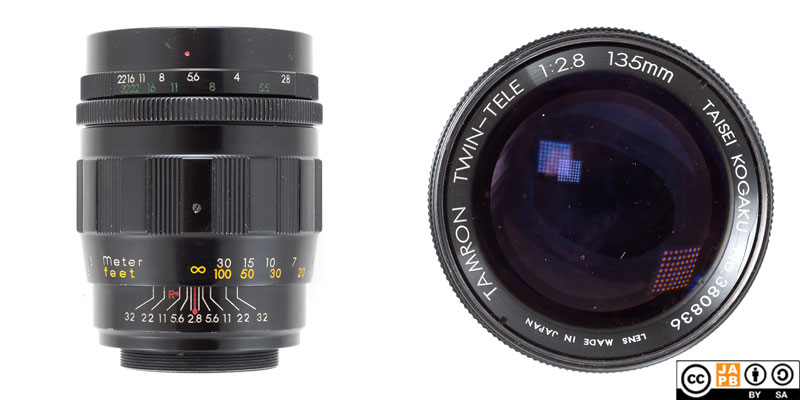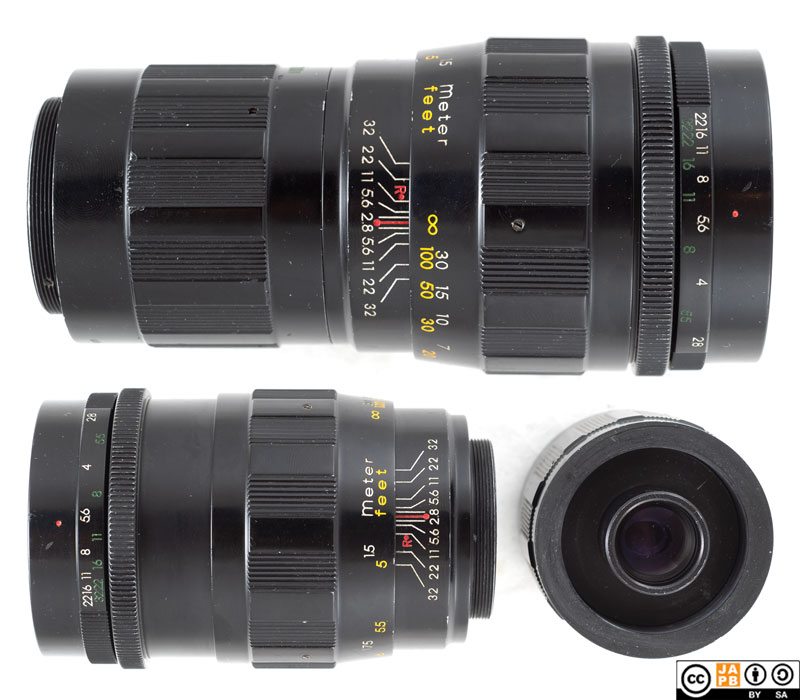Pekka Buttler, 07/2025

Specifications
The Tamron Twin-Tele is an interesting lens that comes with a dedicated teleconverter (TC). You can either use the lens without the TC, at which stage it is a 135 mm f/2.8, or with the TC, making it a 225 mm f/5.5
The table below summarises the lens’ key specifications (measurements based on pictured sample):
| Brand: | Taisei Kogaku (Tamron) | Lens name | Twin-Tele 1:2.8 135mm |
| Focal length(s) 1 | 135 mm 225 mm (with TC) | Angle-of-view 2 | 18° 11° (with TC) |
| Maximum Aperture | f/2.8 f/5.5 (with TC) | In Production | 1960s |
| Lens mounts (native) | T/T-2 | Other lens mounts | – |
| Length 3 | 80,7 mm 129,2 mm | Diameter 4 | 64,8 mm |
| Filter ring diameter | 58 mm | Weight | 429 grams 533 grams (with TC) |
| Lens element count | 4 | Lens group count | 4 |
| Aperture blades (S/R/C) 5 | 12 S | Focus throw | 300 ° |
| Minimum focusing distance (measured) | 144 cms | Maximum magnification (measured) | 1:8,4 1:5 (with TC) |
| Has manual aperture ring | YES | Has manual focus ring | YES |
| Aperture mechanism type | Preset | Aperture click stops (on preset ring) 6 | 2.8•4•5.6•8•11•16•22 |
Further notes:
• This lens was manufactured by Taisei Kogaku, Today better known as Tamron.
• As mentioned above, the base lens is an 135 mm relatively fast medium tele lens, but the specialty is that it also comes with a custom-made teleconverter which modifies the lens into a 225 mm f/5.5.
• This lens uses a T/T-2 intermediate mount. See the JAPB article on the T/T-2 mount for further details.
• This lens is a preset lens with a preset ring featuring full-stop clicks and a clickless aperture control ring.

Bottom: Tamron Twin-Tele 135/2.8 next to its TC
Adapting
Given that this lens uses an intermediate mount, there are several ways to go, depending on what your intention is
To film SLRs or dSLRs?
You’re in luck, because there used to be T/T-2 adapters made for pretty much every mainstream SLR system in history. What you need to do is head to your favourite online classifieds platform and procure an adapter (adapters for dSLR mounts are still available new).
Also, because of the extensive flange focal distance offered by the T/T-2 mount, there are no 35 mm SLR systems that you could not adapt this lens to.
To Mirrorless
Again, not a challenge. If you do not yet have a T/T-2 adapter to an SLR mount, you can buy a T/T-2 adapter straight to your mirrorless mount.
Alternatively, if you have a T/T-2 to SLR mount adapter, you can also daisy chain adapters (for example T/T-2 to Canon FD; Canon FD to mirrorless) to use this lens. If you’re intending to use the lens on a less than full-frame camera, the later approach allows the use of speed boosters.
History of Tamron
A short history of Tamron can be found as part of the Tamron company profile.
Footnotes
- Focal length is (unless stated otherwise) given in absolute terms, and not in Full-frame equivalent. For an understanding of whether the lens is wide/tele, see ‘Angle-of-view’. ↩︎
- Picture angle is given in degrees and concerns the diagonal picture angle. Rule of thumb:
> 90 ° ==> Ultra-wide-angle
70–90 ° ==> Wide-angle
50–70 ° ==> Moderate wide-angle
40–50 ° ==> ‘Standard’ or ‘normal’ lens
20–40 ° ==> Short tele lens
10-20 ° ==> Tele lens
5-10 ° ==> Long tele lens
< 5 ° ==> Ultra-tele lens ↩︎ - Length is given from the mount flange to the front of lens at infinity. ↩︎
- Diameter excludes protrusions such as rabbit ears or stop-down levers. ↩︎
- S=straight; R=rounded; C=(almost)circular at all apertures. ↩︎
- Numbers equal aperture values on aperture ring; • intermediate click; – no intermediate click. ↩︎